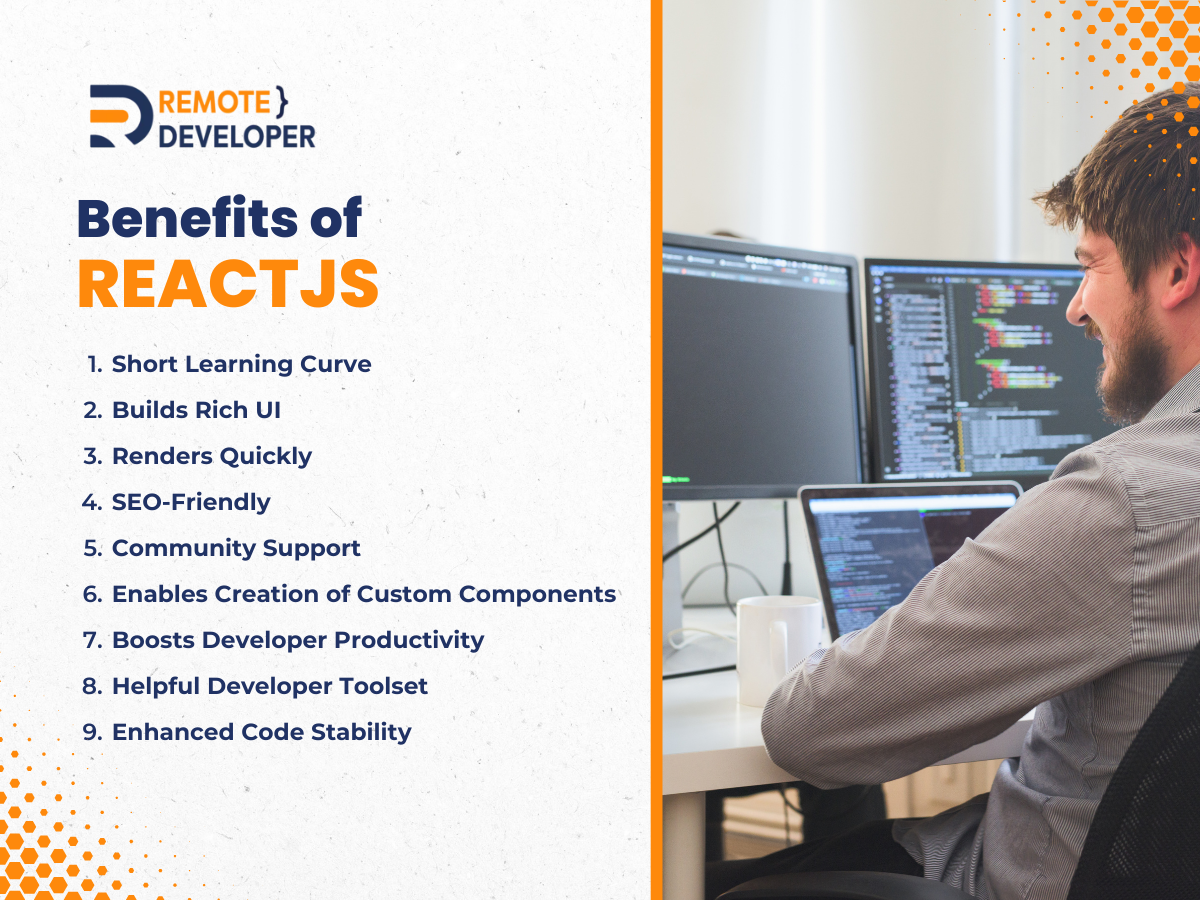Maximise the potential of ReactJS, an open-source JavaScript library designed for building user interfaces with portability in mind. This powerful tool is perfect for helping in a faster web development process by utilising its full capabilities.
In this article, we are sharing more about ReactJS’ key features and components and why learning this is worth it for your upcoming web development ventures.
What is ReactJS?
Developers can use ReactJS as a handy tool to craft user-friendly websites and applications. ReactJS comprises an array of components that developers can easily assemble to create various functional areas of the site or app. The unique design makes these building blocks versatile enough to be reused in different locations without complication.
ReactJS utilises a technique called a virtual version of the website or app to optimise updates for changing segments and improve performance. This approach speeds up the process relative to updating the actual site, resulting in a smoother and faster experience for users.
What is ReactJS used for?
ReactJS enables developers to create user interfaces for web-based applications using a JavaScript library. By allowing developers to create reusable UI components, assign states to those components, and construct applications that refresh on the fly without requiring a page refresh, ReactJS facilitates the creation of active and engaging user interfaces (UIs).
Is ReactJS frontend or backend?
ReactJS is usually used specifically for the front end of web development. Web developers often use ReactJS as a tool for enhancing the appearance and functionality of websites and applications.
It is commonly associated with creating rich and dynamic user interfaces in a fast and efficient manner. However, with the assistance of a companion tool like Node.js, it can also be utilised for backend development. These two tools enable web developers to construct websites and applications that exhibit smooth functionality across both frontend and backend domains.
Features of ReactJS
What makes ReactJS a popular choice? Listed below are the features that make up ReactJS to help you understand why it is the go-to tool for a lot of web developers.
Virtual DOM
ReactJS has a characteristic that helps quicken app development and provides more flexibility. Its algorithm creates a copy of a web page in the virtual memory, which is called the virtual document object model (VDOM).
JavaScript XML or JSX
ReactJS uses a syntax extension called JSX that enables developers to create and manipulate user interfaces in a more readable and concise way compared to plain JavaScript. It appears as a combination of HTML and JavaScript, but it is actually a hybrid of both.
React Native
React Native is a framework that lets developers create mobile apps with ReactJS. It mirrors React’s VDOM and offers code reusability across iOS and Android. Moreover, React Native provides access to native device features like the camera, accelerometer, or geolocation using JavaScript, making it a powerful tool for creating feature-rich mobile applications.
One-Way Data Binding
One-way data binding is a feature that enables data to move in one direction, from the parent component to the child component. The parent passes down the data as ‘props’, which the child can use to render its UI.
Declarative UI
ReactJS offers a straightforward way to write declarative code that creates a user interface based on the semantics of its components, rather than automatically updating the Document Object Model (DOM). This approach is more intuitive and understandable than imperative code because developers only need to focus on describing what they want, rather than coding each step.
Component-Based Architecture
To develop user interfaces (UIs), ReactJS uses a component-based architecture. These components represent individual elements in the UI, such as buttons, forms, or images, and are self-contained units of code. Each component can have its properties and behaviour and can be combined to create more complex user interfaces.
Fundamentals of ReactJS
ReactJS’ fundamentals serve as the building blocks that provide a solid foundation for robust and scalable app and web development, in addition to its features. Furthermore, these fundamentals make it easier for developers to follow ReactJS’ best practices.
- Provide a clear understanding of ReactJS’ architecture.
- Help developers write clean and easy-to-maintain code.
- Facilitate the development of complex applications.
- Make it easier for developers to learn new concepts and features.
Components of ReactJS
Functional components: A simple way to define a component using a function that returns JSX. They are typically used for presentational components or stateless components.
Class components: More complex than functional components, class components are defined as a class that extends React.Component class. They have lifecycle methods and can contain states, making them more suitable for complex logic and stateful components.
Props: A way to pass data from “parent components” to “child components.” Props are read-only and are used to customise the behaviour and appearance of a component.
State: An object that represents the current state of a component. The state can be modified using the setState method, and changes to the state trigger a re-render of the component and its children.
Lifecycle methods: A set of methods that are invoked at different stages of a component’s lifecycle, such as when the component is created, updated, or removed from the DOM. Developers can use these methods to perform tasks like fetching data or cleaning up resources.
Events: A way to handle user interactions, such as clicks or key presses, by defining event handlers in a component.
Refs: A way to reference a specific DOM element or component instance in a ReactJS application. Refs can be used to interact with the underlying DOM, such as setting focus on an input field.
Context: A way to pass data through the component tree without having to pass props down manually at every level. Context provides a way to share data between components that are not directly related to the component tree.
Higher-order components: A pattern for reusing component logic by wrapping a component in a function that adds additional behaviour. Higher-order components help abstract away common functionality, such as handling loading states or authentication.
Error boundaries: A way to handle errors that occur within a component’s children, preventing the entire application from crashing. Error boundaries are defined as a component that catches errors using the componentDidCatch lifecycle method.
Benefits of ReactJS
ReactJS is a popular tool for web developers. Aside from the ease it provides throughout the app and web development process, it also provides a couple more benefits as well.
Short Learning Curve
ReactJS is a user-friendly web development tool that can be easily understood by those with basic developer skills. Its simple principles and limited API make it less daunting for newcomers.
Builds Rich UI
Great UIs that offer a captivating user experience will have a higher chance of success than one with a poor interface. With ReactJS, it is easy to create engaging, high-quality interfaces. It is a powerful tool for building current web applications with responsive and interactive UIs.

Renders Quickly
One of the best advantages of using ReactJS is its JSX components, which can be customised to fit your needs. It also grants developers the ability to create high-volume applications and build React Element trees from HTML mockups.
In addition, ReactJS’ force rerender feature allows for manual updating of the UI for it to refresh faster when it does not update automatically due to asynchronous updates or other elements.
SEO-Friendly
To achieve success, an app must be liked by search engines. Two things that are key to an app’s performance are fast loading time and rendering. ReactJS features ultra-fast loading speeds, which can significantly reduce page load time and help businesses get their apps noticed on the first page of Google search.
Additionally, ReactJS’ iframe can also support the website’s SEO. This method can boost user engagement. However, it should be implemented cautiously since an incorrect implementation may negatively impact performance.
Community Support
The ReactJS community is extremely active, providing helpful resources such as libraries and thorough documentation to facilitate learning. They maintain a presence on platforms such as GitHub and StackOverflow to keep the ReactJS community informed of new changes and provide timely answers to meet developers’ needs.
Enables Creation of Custom Components
ReactJS offers developers the benefit of creating customised components to suit their needs. These components are like Lego blocks, as they can be combined to form complex interfaces.
Furthermore, ReactJS and GraphQL can be used together for even more powerful applications. With ReactJS, developers can create custom components that query only the desired data, while GraphQL provides a type system to validate data flow between components and ensure accurate results.
Boosts Developer Productivity
ReactJS offers several advantages that make it an ideal tool for developers. With its component-based architecture, developers can create individual reusable components, and with a VDOM, they can quickly and efficiently update the UI.
Moreover, ReactJS already provides built-in UI components such as radio buttons, making development smoother and more straightforward. With a declarative programming model, designers do not have to worry about the implementation details so they can focus on the interface they want.
Helpful Developer Toolset
ReactJS has a wide selection of tools and functions that let developers reuse code. These include a component-based architecture, VDOMs, and reusable UI elements.
Furthermore, the ReactJS developer community is focused on producing open-source libraries and sharing insights to offer more resources and support. This contributes to the ReactJS flourishing community of coders who are passionate about crafting progressive web apps through knowledge exchange and collaboration, leading to plentiful accessible materials and assistance.
Enhanced Code Stability
ReactJS’ downward data flow prevents changes to a child structure from impacting its parent. This feature prevents changes to a child’s structure from impacting its parent. Developers can modify an object by simply updating its states, and only that component will be altered while others remain unaffected.
Plus, the debugger helps developers identify and fix errors quickly. These features make ReactJS great for creating secure web applications.
Final Thoughts
In conclusion, ReactJS has revolutionised the way we build web applications. Its ease of use, flexibility, and performance have made it a popular choice among developers. Its component-based architecture allows for reusable code, making development faster and more efficient.
ReactJS also integrates seamlessly with other technologies and has a robust developer community that provides support and resources. As interest continues to evolve, ReactJS will undoubtedly play a significant role in shaping the future of web development.
Need expert developers with ReactJS in their tech stack? Choose from our pool of top-rated IT talents and hire your dedicated team of remote developers. Get in touch with us today to get started.

